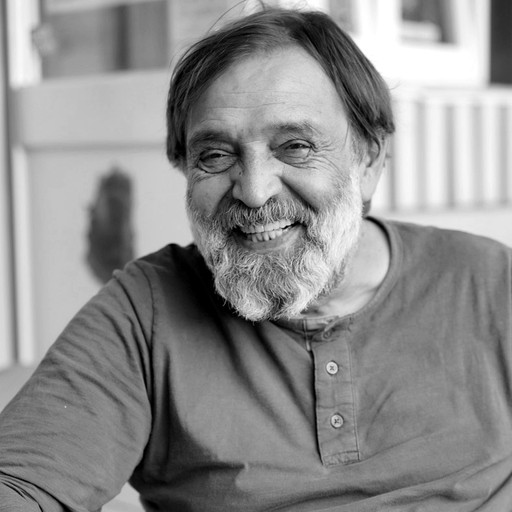Alfred Ullrich is a graphic, video and action artist based in Dachau. Born in Schwabmünchen, Bavaria, in 1948 as the son of a German and an Austrian Sintezza, he sees himself as an outsider among outsiders. His work revolves around the question of the relationship between mainstream German society and that of the Sinti and Roma, and aims to provoke century-old prejudices cemented in the collective subconscious of society. He also investigates his own family history: Ullrich’s entire family was sent to Nazi concentration camps, where most of them were murdered. His mother’s experiences in the camps also traumatised Ullrich, and thus pain, death and vulnerability flow into his work. He spent his first nine years in a caravan on the northern outskirts of Vienna, then after his schooling he travelled throughout Europe and worked as a stagehand for a theatre and in a manual printing workshop in Munich. He began using printing experimentally as a medium to create his own abstractions, which resonate between beauty and coarseness, grace and provocation. His drypoint etchings are delicate, mostly abstract images which reveal the process of printing itself and dematerialisation. The interplay of opposing forms and colours on the multifaceted surfaces reflects traces of the physical destruction of the printing plates.
Ullrich’s performance art is more political. His first art action, Perlen vor die Säue [Casting Pearls Before Swine], in 2000 was a single iconographic scene: Ullrich stood in front of the entrance gate to the Lety concentration camp and let pearls drop to the ground from his open hand. He referred to the scandal that the former death camp, a site of the mass murder of Roma and Sinti, was being used as a pig farm. The performance was part of the Call the Witness exhibition at the 2nd Roma Pavilion of the 54th Venice Biennale in 2011.
As a keen observer, Ullrich challenges antiquated views and behaviours, for he often finds discrimination against the different and unknown in language and images. In 2006 in his piece Transidentities, he criticised the condition of the public toilets on a former caravan site near Dachau, but after Ullrich had photographed and filmed the area the toilets disappeared overnight and a mobile toilet was put in their place. Five years later, Ullrich asked for the removal of the sign bearing the discriminatory inscription ‘Landfahrer kein Gewerbe’ [ Site for Travellers: No Trading], because the term Landfahrer was used during the Nazi era as a synonym for Roma. His dialogue with Dachau municipal authorities was difficult.
Ullrich continues to exhibit worldwide, with his declared mission to ‘uncover mainstream society’s relationship to Sinti and Roma society today’.
Selected Solo Exhibitions
1984
Kulturzentrum Zeche Carl, Essen
1985/86
Small Gallery Young Art, Waldkraiburg
1987
Atavisms – L. Pichl and W. Wires, Gallery piek + fein, Berlin
1988
Grafika – N. Kiening, Diöcesan Museum, Katowice, Poland
1993
KVD, Dachau, with G. Gottschalk and H. Müller-Cejka
Artothek Treptow, Berlin
1996
Artist’s house, Ivano-Frankivsk, Ukraine
1997
‘X’ – Franziskuswerk, Schönbrunn
1999
FarbenFormenStrukturen – KVD, Dachau
Havanna Lounge – Vienna
2000
Pearls Before Swine – performance, Lety, Czech Republic
Twenty Years of Lyrical Abstractions – T.W. Wood Gallery, Vermont, USA
2002
Farbe Form Struktur – with C. Sattler-Nefzger, Wasserturm Dachau
2003
Rahmen los …! – KVD, Dachau
2006
Six Times Nothing on Three Plates – Muzeum Romské Kultury, Brno
Transidentities – Neue Galerie Dachau
2008
Illustrations to Matéo Maximov’s novel The Ursitory – House of Minorities, Prague
2009
roll-on, roll-off – A41 Gallery im Hof, Vienna
Transidentities – zentrum edition exil, Vienna
2011
Transidentities III – Galerie Kai Dikhas, Berlin
2014
Blackout – Greyout Whiteout Braunau(t) Apartment of Art, Munich | Documentation and Cultural Centre of German Sinti and Roma, Heidelberg | Galerie Kai Dikhas, Berlin
2015
Carte blanche – with Konrad Dördelmann, Kunstverein Schrobenhausen
2016
Rolling Home – Galerie Kai Dikhas, Berlin
Selected Group Exhibitions
1995
Impreza (honourable medal) – Ivano-Frankivsk, Ukraine
1999
Osnaka99 – Ivano-Frankivsk, Ukraine
2001
Haus der Kunst, Munich
2003
AK 68 – Wasserburg, Inn
2005
Post Für Dachau – KVD, Schloss Dachau
AK 68 – Wasserburg, Inn
2007
Rainbow Soldier, Liquid Heart – Stadtturm Galerie, Innsbruck, Austria
2009
The Aquarellis – KVD Galerie, Dachau
2010
Love and Friendship in the Nuclear Age – Gallery Dana Charkasi, Vienna
Romale! 10 – Kunstraum Next Andrä, Graz
2011
EuroArt, contemporary art of the Dachau artists’ colony – Pesterzsébeti Múzeum, Budapest
Gadschi, Roma, Sinti, Manouches… Positions between exclusion and acceptance – KVD, Dachau
roma protocol – Parliament of Vienna
Call the Witness, 2nd Roma Pavilion, 54th International Venice Biennale | Utrecht
Stopping Places – Galerie Kai Dikhas, Berlin
KVD members’ exhibition, Dachau
2012
What’s in a Frame? – www.3 stations.de, Munich
the killer rabbit ranch rodeo – National Museum Berlin and Studio Norrmann Biberbach / Röhrmoos
showrom – Stimmen der Roma [Voices of the Roma] – Munich Adult Education Centre
Stopping Places II – Galerie Kai Dikhas, Berlin
KVD members’ exhibition, Dachau
2013
Neuland – Apartment of Art, Munich
Romani Lives – Kunsthalle Exnergasse (WUK), Vienna
The Ministry of Education warns: Segregation seriously harms you and the people around you –Prague, Czech Republic (story of the Landfahrerplatz, Dachau)
Stopping Places II – Galerie Kai Dikhas, Berlin
2014
Akathe Te Beshen / Here to stay – Galerie Kai Dikhas
Kathe Ham Mer Kheri / Here We Are at Home – Galerie Kai Dikhas,
KVD members’ exhibition, Dachau
Stopping Places IV – Galerie Kai Dikhas, Berlin
2015
Transmitting Trauma? – Galerie Kai Dikhas, Berlin
Stopping Places V, Galerie Kai Dikhas, Berlin
Selfie – KVD members’ exhibition, Dachau
2016
Trautes Heim – KVD, Schloss Dachau
Akathe Te Beshen / J’y suis. J’y reste – Rivoli59, Paris
Be Free! – Heidelberg Castle | Ottheinrichsbau, Berlin
Galerie Kai Dikhas, Berlin
2017
Akathe Te Beshen – Mestipe Thaj Sastipe
CentroCentro – Cibeles de Cultura y Ciudadanía, Madrid, Spain
Today Is Yesterday – Galerie Kai Dikhas, Berlin
Source: the artist




